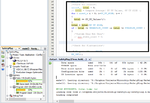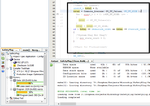xpress_embedo
Advanced Member level 4

Hello!,
I am using PIC12F1571 micro-controller do develop an application, this micro-controller has very less RAM, just 128 bytes, so while designing this application, i have to take care of RAM also.
I need to calculate average on an array, can anyone please tell me, why RAM and ROM size gets changes drastically by using the function for that.
Here is case1, when i didn't used function for computing average.
In this case RAM = 54 bytes and ROM = 335 bytes

Now case 2, where i used function for computing average, and the function is as follow:
RAM = 65 bytes and ROM = 393 bytes
So 11 bytes increased in RAM and 58 bytes in ROM, can someone please help me in understanding this thing.

Thanks in advance.
I am using PIC12F1571 micro-controller do develop an application, this micro-controller has very less RAM, just 128 bytes, so while designing this application, i have to take care of RAM also.
I need to calculate average on an array, can anyone please tell me, why RAM and ROM size gets changes drastically by using the function for that.
Here is case1, when i didn't used function for computing average.
In this case RAM = 54 bytes and ROM = 335 bytes

Now case 2, where i used function for computing average, and the function is as follow:
Code C - [expand]
RAM = 65 bytes and ROM = 393 bytes
So 11 bytes increased in RAM and 58 bytes in ROM, can someone please help me in understanding this thing.

Thanks in advance.
